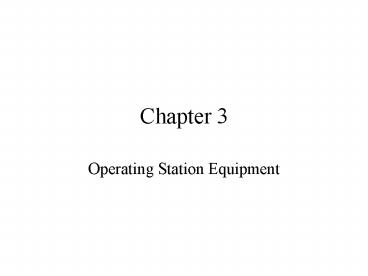Operating Station Equipment - PowerPoint PPT Presentation
1 / 28
Title:
Operating Station Equipment
Description:
PTT (push to talk). VOX (voice operated transmit). Receiver Functions ... A Gateway amateur radio station is used to connect other amateur stations to the Internet. ... – PowerPoint PPT presentation
Number of Views:32
Avg rating:3.0/5.0
Title: Operating Station Equipment
1
Chapter 3
- Operating Station Equipment
2
3.1 Transmitters Receivers
- Transmitter, for sending.
- Receiver, for listening.
- Transceiver, all in one (most likely).
3
Rig Buttons and Knobs
4
Basic Operation-Selecting Band, Frequency, and
Mode
- Band Switch
- V/U--Toggles between VHF 2m and UHF 70 cm.
- Band--Advances in a ring 50, 144, 222, 432, and
1296 MHz. - May have a button dedicated to each band, you
should be so lucky.
5
Frequency Selection
- VFO (Variable Frequency Oscillator) Big Knob or
Microphone up/down buttons. May have selectable
step sizes (TS). - Memory channel select, rotary or up/down on
Microphone buttons. - Keypad direct entry.
6
(No Transcript)
7
(No Transcript)
8
Mode Selection
- FM--Simplex or Duplex.
- USB--Upper Sideband
- LSB-- Lower Sideband
- CW-- Morse Code
- Data-- for RTTY or other digital modes
- May be dedicated select buttons or a single Mode
button to pick from a ring of modes.
9
Key Features
- A memory channel may record Band, Frequency,
Mode, Power level, and CTCSS access tones if
required. - F--Function key first, selects an alternate
function for the regular keys, until it times out.
10
(No Transcript)
11
Transmitter Functions
- RF Power control, H/L, steps, continuous.
- Microphone gain, too much may give distortion
and/or splatter on SSB and over deviation on FM. - Speech compression, too much may cause distortion
and/or splatter. - Audio feedback from speaker to mic.
- RF feedback into mic can cause distortion.
12
(No Transcript)
13
Transmitter Checkout
- Follow the equipment manual, use a dummy load for
initial setup. - With an antenna, check with an honest friend
across town for a clean signal. - Monitor ALC (automatic level control)
- What is a good reading for a clean signal?
14
Going to transmit mode
- PTT (push to talk).
- VOX (voice operated transmit).
15
Receiver Functions
- AF (Audio Frequency) gain/volume control.
- RF (Radio Frequency) gain control and
Attenuator/Pre Amplifier button. - AGC (Automatic Gain Control) slow for SSB, fast
for CW/Data. - SquelchQuiets noise when no signal is being
received.
16
More Receiver Functions
- Noise Blanker eliminates pulse noise.
- Notch Filtering of steady tones, may be automatic
via DSP (Digital Signal Processing). - RIT (Receiver Incremental Tuning) helps in nets,
a group of stations that should be on the same
frequency.
17
Digital Data Modes
- A TNC (Terminal Node Controller) is connected
between the radio transceiver and the computer
terminal in a packet station. - Audio tones from the speaker jack and to the
microphone jack are provided by hardware in the
TNC or Soundcard. - No Microphone required for packet radio.
18
More Digital
- A Gateway amateur radio station is used to
connect other amateur stations to the Internet.
19
3.2 Antenna Systems
- Length of a Dipole antenna in feet is 468 divided
by the frequency in MHz. - Note that this is an inverse relationship, the
antenna needs to be shorter as the frequency
increases. T9A05
20
Six Meter Example
- For 50.143 MHz (Six Meters) 468/50.1439.33 feet
or 112 inches. T9A12
21
6 m Dipole example
- For 50.143 MHz (six meters) 468/50.1439.333 ft
or 112 inches. T9A12
22
Polarization
- If the radiating elements of the dipole are
deployed parallel to the ground, then the dipole
by definition produces horizontal polarized waves
and the strongest signal is broadside to the
elements. - Called a horizontal antenna. T9A03
23
Ground Plane Antenna
- Length of a Ground Plane antenna in feet is 234
divided by frequency in MHz. - Example For 146 MHz (Two Meters), 234/1461.6
feet or 19.23 inches, approximately 19 inches.
T9A11
24
Polarization
- Usually a Ground Plane antenna is deployed with
the radiating element perpendicular to the
ground, then it produces vertical polarized waves
and has an omni directional pattern of strength. - Any antenna with radiating element vertical is
called a vertical. T9A02
25
Ground Plane (continued)
- An efficient and handy mobile antenna is a magnet
mount vertical antenna. T9A09
26
Portable Antennas
- A Rubber Duck antenna is not efficient because of
its small size, but very handy on a portable.
T9A04 - Used inside a car, it is down in strength by a
factor of 10 to 20 times because of shielding by
the metal of the car. T9A10
27
Beam Antennas
- Adding additional parasitic elements T9A01
(reflectors and directors) can concentrate the
strength pattern into a beam of energy. - Linear elements give a Yagi Beam.
- Loop elements give a Quad Beam. T9A08
28
Yagi Beams































